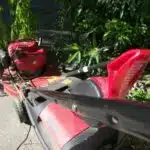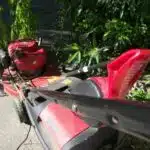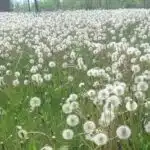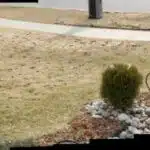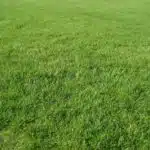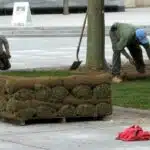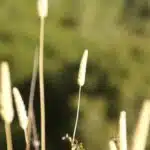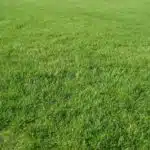Having a lush, green lawn is the envy of many homeowners. It adds beauty to your property and creates an inviting outdoor space for entertaining and relaxing. But creating a beautiful, green lawn requires more than just regular mowing and watering; it takes careful planning and effort. If you’re up for the challenge, here are some tips for growing a green lawn that will help you achieve the perfect look.
First, prepare your soil by testing its pH level and correcting it if necessary. You should also add organic material like compost or manure to improve its fertility levels. This will ensure that your grass has all the nutrients it needs to thrive and stay healthy.
Second, choose grass seed carefully based on your climate, soil type, and use of the lawn. For example, shady areas require different types of grass than sunny areas do. Once you’ve chosen the right type of seed for your area, you’ll need to consider how much seed to apply based on coverage area and desired thickness of growth.
Finally, when planting your grass seed make sure to water regularly so that the soil is moist but not too wet or saturated with water. This will help promote strong root growth in order for your lawn to become lush and healthy over time. In addition to watering correctly, be sure to mow regularly at the recommended height according to the type of grass that you have planted in order to promote additional growth from existing plants as well as new ones coming up from seeds planted earlier.
With these tips for growing a green lawn in mind, you can create a beautiful outdoor space that everyone will enjoy!
Choose The Right Type Of Grass For Your Region
Studies show that out of the roughly 1 billion acres of lawns in the United States, nearly 40 million of them are maintained by professional landscapers. As such, growing a lush, green lawn is an important goal for many homeowners and landscapers alike. With the right knowledge and some patience, any gardener can achieve a beautiful green lawn they can be proud of.
When it comes to achieving a healthy and green lawn, selecting the right type of grass for your region is key. Depending on where you live in the US, there are several different types of grasses suitable for growing in your climate. For example, cool-season grasses such as Kentucky bluegrass or fescue do well in cooler climates with cold winters and hot summers while warm-season grasses like Bermuda or St. Augustine work better in warmer climates with mild winters and hot summers.
It’s also important to select a shade-tolerant grass variety if you have trees or other structures which cast shadows on your lawn for most of the day. Shade-tolerant varieties include turf-type tall fescues, fine fescues, ryegrass, zoysia and centipede grasses – all being viable options depending on your local climate and soil conditions. Planting these shade-tolerant varieties will ensure that even areas of your yard with less sun will remain lush and green throughout the year.
By choosing the right type of grass based on your local climate and soil conditions, you’ll be setting yourself up for success when it comes to achieving a beautiful green lawn that is sure to draw admiration from family and friends alike!
Select A Shade-Tolerant Grass Variety
It has long been theorized that the type of grass you choose to grow in your lawn plays a major role in its success. To test this theory, we can look at the varying types of grasses grown across different regions and climates. It is easy to see that the best results come from selecting a grass variety that is adapted to local conditions.
When it comes to creating a lush green lawn, choosing the right type of grass for your region and climate is key, but even more important is selecting a shade-tolerant variety. Not all varieties of grass can tolerate shady conditions, so if your lawn area is partially or completely shaded by trees or other structures, then it’s essential to pick a shade-tolerant variety. Certain species of grass such as bentgrasses, fescues and ryegrasses are better suited for growing in shadier areas than those commonly found in sunnier spots like Kentucky bluegrass or bermudagrass.
Before planting any kind of grass seed into your yard, it’s also important to prepare the soil first. The soil should be free from weeds and debris before laying down fertilizer, aerating or adding composted matter. This will help give the new grass seedlings a good start and ensure they will have enough nutrients available during their early development stages.
Prepare The Soil Before Planting
When it comes to growing a green lawn, preparing the soil is just as important as selecting a shade-tolerant grass variety. The soil must be prepared correctly to ensure that the grass has the best chance of becoming established and thriving in its new home. Here are some tips for preparing your soil for planting:
- Test the pH level of the soil to make sure it’s suitable for growing grass.
- Incorporate organic matter into the soil to improve its structure and fertility levels.
- Remove any debris or stones from the area where you plan to sow your grass seeds.
- Till the soil deeply, which will help with nutrient uptake and water absorption by the roots of your plants.
As a botanist and gardener, I recommend taking these steps prior to planting in order to have success with a healthy lawn that will last for years to come. Preparing the ground properly will also give you an advantage when it comes time to plant grass seeds at the right time later on in your process. This way, you can maximize your chances of achieving lush, green growth over time!
Plant Grass Seeds At The Right Time
Growing a green lawn is an important part of creating a beautiful and healthy landscape. To do this, it’s essential that the soil be prepared correctly before planting and that the grass seeds are planted at the right time. Let’s take a look at how to do both of these steps for success.
First, soil preparation is key to achieving a lush and green lawn. The soil should be cleared of any debris and then aerated with either a core aerator or by raking vigorously with a garden fork. Additionally, ensuring that the soil pH is between 6.0 and 7.0 will provide optimal grass growth conditions. Fertilization of the soil should also be undertaken prior to seeding in order to give the grass seedlings the nutrients they need to flourish when they germinate.
The next step is planting grass seeds at the right time of year. Depending on your climate and type of grass, you may have different needs as far as timing goes but it’s generally best to plant during early spring or late fall when temperatures are not too high nor too low for germination success. Additionally, when planting seeds make sure to spread them evenly over the area so that each seed has enough space to grow without competition from its neighbor plants. Planting more densely can lead to crowding which can cause stress on your lawn and reduce its healthiness overall.
By following these two steps you’ll be well on your way towards having a thriving green lawn! With proper preparation and timing, you can ensure your lawn will look great year-round.
Water Your Lawn Regularly
Watering your lawn regularly is like filling a glass with water – it’s essential to keep it healthy and vibrant. As a specialist in botany and gardening, I’m here to tell you that proper watering is the key to having a lush, green lawn.
First and foremost, it’s important to determine how much water your grass needs. You can do this by consulting local weather reports or checking soil moisture levels with a specialized tool. Once you have an idea of the amount of water needed for your lawn, stick to a consistent schedule. This will ensure that the grass receives the right amount of hydration without getting over-saturated.
Additionally, try considering more sustainable methods of watering such as using rain barrels or an underground irrigation system. These types of systems can help reduce runoff and conserve water while still providing ample hydration for your lawn.
By following these tips on how to properly water your lawn, you can be sure that you’re doing all you can to help keep your grass looking its best and serving others in the process! Now let’s take a look at how mowing your lawn properly contributes to having a healthy yard.
Mow Your Lawn Properly
On the journey to a lush, verdant lawn, mowing plays an essential role. It’s like taking scissors to the hair of your beloved pet – done incorrectly and it will look bad, done properly and you’ve got a showstopper. To ensure that your grass looks its best, here are some tips for proper mowing:
• Start High: The rule of thumb is to cut no more than one-third of the grass blade at a time. Starting on the high side ensures that you don’t over-trim your turf.
• Cut Often: Depending on the season, you may need to mow as often as once or twice a week or cut back to once every two weeks or so. This keeps your lawn looking tidy and prevents it from becoming too long and unruly.
• Alternate Directions: Mowing in the same direction can lead to rutting and unevenness in your lawn. Change up the pattern each time you mow by alternating directions so that all blades of grass get equal light exposure and nutrients.
By following these three tips for proper mowing, you’ll be well on your way to greener pastures! Additionally, using the right amount of fertilizer will ensure that your lawn remains healthy and vibrant all year round.
Use The Right Amount Of Fertilizer
Fertilizing your lawn is a key part of ensuring lush, green grass. It’s the perfect way to nourish and feed your yard, helping it reach its full potential. Here are three tips to use the right amount of fertilizer:
Firstly, conduct a soil test to determine the fertilizer requirements for your lawn. This will help you identify any deficiencies in nutrients and will ensure that any fertilizers you apply have the right balance of nutrients for optimal growth. Furthermore, it will also prevent overfertilization which can lead to an unhealthy lawn.
Secondly, use slow-release fertilizers whenever possible. These types of fertilizers release their nutrients gradually over time, providing a more consistent supply of essential nutrients for your lawn. Additionally, they provide long-term protection against nutrient deficiencies and reduce the chances of leaching away into the environment.
Lastly, use organic fertilizers and soil amendments when available. Organic materials such as compost and mulch provide valuable nutrition for your turf while also improving soil structure and water retention capacity. They also promote microbial activity in the soil which can help stimulate root growth and improve overall health of your lawn.
By following these tips for using the right amount of fertilizer on your lawn, you can ensure lush green grass that is both healthy and sustainable in the long run. Next up: aerating your lawn for better soil health!
Aerate The Lawn For Better Soil Health
Aerating a lawn is an essential part of maintaining healthy soil and growing a lush, green lawn. It increases the ability of the soil to absorb water and nutrients, allowing plants to take root more easily and grow stronger. Aeration also helps reduce compaction, ensuring that oxygen can reach the roots of plants for better growth and health.
In order to aerate your lawn, you will need to rent or purchase an aerator that punctures small holes in the surface of the soil. These small holes allow water, oxygen, and other nutrients to penetrate the soil more deeply, encouraging strong root growth. It’s important to remember that when you aerate your lawn, it should be done when the ground is moist so that the cores created by the aerator can be broken down by microbial activity in the soil.
Regular aeration of your lawn will help keep it healthy and green all year long. This simple task can improve drainage in heavy soils, add beneficial microbes back into depleted soils, strengthen roots systems and encourage new grass growth. Plus, it will make your lawn look beautiful!
TIP: You can maximize the benefits of aerating your lawn by using organic fertilizers or compost afterwards; this will help encourage even greater root growth and stronger grass shoots.
Use Organic Lawn Care Methods
Organic lawn care methods provide a holistic approach to lawn maintenance that favors natural solutions over chemical treatments. It is a form of gardening that works in harmony with the environment and promotes healthy, thriving lawns. Through this creative process, gardeners can create lush, green spaces without the need for harsh chemicals or expensive equipment.
Organic lawn care involves using natural materials such as compost, mulch, and grass clippings to nourish the soil. This helps to promote healthy microbial activity in the soil which can lead to more robust root growth and better water absorption. The addition of organic matter increases soil fertility and helps maintain an ideal balance of pH levels for grass growth. Additionally, organic fertilizers are a great way to feed your lawn while avoiding potential harm caused by synthetic fertilizers.
Organic methods also encourage beneficial insects such as ladybugs and bees which help control pests naturally. Finally, applying natural pesticides like neem oil or garlic oil can help protect against common lawn pests without introducing potentially hazardous chemicals into the environment. By embracing organic approaches to lawn care, gardeners can enjoy beautiful green spaces without compromising their commitment to environmental stewardship. With some patience and creativity, anyone can achieve stunning results using organic methods in their yard or garden.
Control Weeds In Your Lawn
The art of gardening is an ancient one, and over the centuries, it has been honed to a fine level of sophistication. In modern times, a green lawn is often seen as the epitome of success in gardens. To achieve this, a gardener must be attentive to the weeds that threaten to take over their lawn. As such, controlling weeds in your lawn is an essential step on the path to a lush and verdant landscape.
As with any form of garden maintenance, prevention is better than cure. A well-maintained lawn should be kept free from weeds; however, where these have already taken root, there are several methods for controlling them. The first step is to identify which weed you are dealing with; some weeds can be removed manually by hand with little effort, while others may require more specialist techniques such as herbicides or mulching.
Once you have identified the weed and assessed which method of removal will work best for you, it’s important to apply it consistently. Weeds can spread quickly if left unchecked; so regular monitoring and treatment are key components of successful weed control. Additionally, using organic methods whenever possible can help to minimize environmental damage and keep your lawn healthy for years to come.
With these simple steps in mind, a gardener can ensure they stay ahead of any potential weed issue and enjoy a beautiful green lawn all year round!
Prevent Diseases In Your Lawn
Did you know that lawn diseases can cause up to 40 percent of lawn deterioration? This is why it’s so important to prevent diseases in your lawn. As a specialist in botany and gardening, I have strategies for prevention that will help you create a lush, green lawn.
The first step is to understand the types of diseases that can affect your lawn. Common fungal diseases include dollar spot and brown patch, both of which are caused by excessive moisture, humidity and poor air circulation. Other common issues include rust, which is spread through spores on the wind and soil-borne nematodes that feed on plant roots.
Once you understand the types of lawn diseases, you can take steps to prevent them. Proper mowing practices are essential; keeping your grass at least two inches tall helps reduce stress and moisture loss from evaporation. Additionally, use organic fertilizers to build healthy soils and introduce beneficial microorganisms that fight disease organisms naturally. Finally, make sure your irrigation system is correctly calibrated to ensure even coverage without over-watering.
By following these steps and understanding the types of diseases affecting your lawn, you can keep it looking its best for years to come!
Provide Shade For Your Lawn
Providing shade for your lawn is a critical step in maintaining its health. Without adequate shade, photosynthesis will be impaired and this can lead to weakened grass and an overall yellowing of the lawn. Moreover, intense sunlight can lead to desiccation and sunburn of grass blades. As such, it is essential for gardeners to provide some form of shading for their lawns.
There are several methods you can use to provide shade for your lawn. If you have trees in your yard, you can strategically place them so that they cast a shadow over the parts of the lawn which receive direct sunlight throughout the day. Alternatively, you can also install an awning or canopy over your patio or deck to protect the surrounding grass from excessive sun exposure. Finally, using a combination of different plants and shrubs will also create enough shade for your lawn without needing any additional structures or materials.
No matter what method you choose, providing adequate shade for your lawn is key to keeping it healthy and lush all year round. With proper maintenance and care, you’ll be able to enjoy a beautiful green lawn that will be the envy of the neighborhood! Moving forward, another important aspect in ensuring a healthy green lawn is reducing foot traffic in order to prevent soil compaction and damage to the grass itself.
Reduce Foot Traffic In Your Lawn
Reducing foot traffic in your lawn is an important factor when it comes to maintaining a lush, green lawn. Foot traffic can cause compaction of the soil, which makes it difficult for water and nutrients to penetrate the grass roots. This can result in brown spots on the lawn, or even bare patches. It’s also important to reduce the amount of wear and tear on your lawn from activities like sports or large gatherings.
In order to protect your lawn from excessive foot traffic, consider placing stepping stones or other paths in areas where people frequently walk. These paths will help keep people off the grass, but still allow them access to certain parts of your yard. You can also use mulch around trees and shrubs as a way to provide an attractive yet durable surface that won’t be damaged by foot traffic.
Finally, avoid using fertilizers or herbicides around pathways; these substances can be harmful if they are tracked onto other parts of the yard by shoes. By taking these simple steps you can ensure that your lawn remains healthy and vibrant despite being subjected to foot traffic. With proper care and attention, you’ll have a beautiful green lawn that will last for many years to come!
Control Pests In Your Lawn
The lush, deep green of a well-maintained lawn is a sight to behold. Its beauty and health are a reflection of the care taken to nurture it. Controlling pests in your lawn is essential to achieve that perfect look and maintain its health. Here’s how:
Monitor your lawn regularly for signs of pests. Insects, mites, and other organisms that live in the soil can harm the grass if left unchecked.
Use natural methods like mulching or planting companion plants to discourage pests from invading the lawn. These methods can also help improve soil quality and encourage beneficial insects to establish themselves in the garden.
Consider using organic pesticides as a last resort if pest populations become too high for natural methods to control them effectively. Be sure to select an appropriate product for your particular situation and read all directions carefully before applying any pesticide products.
If necessary, seek professional help from a qualified lawn care specialist who can identify the pest problem accurately and recommend appropriate treatments specifically designed for your type of lawn.
Pests can quickly cause damage to your lawn if not controlled properly, so it’s important to be vigilant about monitoring and taking action when necessary. It’s possible even with small efforts over time that you can keep pests away from your lawn while still enjoying its beauty and health!
Consider Lawn Alternatives
Deciding on an alternative lawn option is like walking a tightrope – one wrong step and the results can be disastrous. With that in mind, it’s important to consider all your options carefully before deciding on a new approach.
There are a few different alternatives to traditional grass lawns, depending on your lifestyle and needs. Ground cover plants such as creeping thyme, pachysandra, or vinca minor make a great alternative for those looking for low-maintenance solutions. For those who want something more elaborate, ornamental grasses are also an attractive option. And don’t forget about artificial turf – it may not be natural but it does require less maintenance than real grass!
Finally, if you want a truly unique look for your outdoor space, you might even consider xeriscaping with native plants and hardscape elements like rocks, gravel, or pavers. No matter what type of alternative you choose, it’s important to do your research and find out what works best in your climate and soil conditions.
TIP: Consult with a specialist in botany and gardening to ensure you get the best advice when choosing an alternative lawn option that fits your lifestyle and needs.
Frequently Asked Questions
How Often Should I Fertilize My Lawn?
Fertilizing your lawn is an important part of keeping it green and healthy. So how often should you fertilize? That depends on the type of grass growing in your yard and the climate where you live.
In general, warm-season grasses like Bermudagrass or St. Augustinegrass need more frequent fertilization than cool-season grasses like Kentucky bluegrass or fescue. In most areas, warm-season grasses should be fertilized four times a year (spring, summer, fall and late winter), while cool-season grasses may only need two applications (spring and fall). It’s also important to adjust your fertilizer schedule based on the weather conditions in your area – for example, if you have an unusually wet spring or summer, you may need to reduce the amount of fertilizer applied.
Overall, to keep your lawn looking lush and green, it’s best to follow a regular fertilization schedule that takes into account both the type of grass in your yard and the climate where you live. When done correctly, fertilizing can help ensure that your lawn stays healthy and vibrant throughout the year.
What Are The Benefits Of Aerating My Lawn?
What are the benefits of aerating your lawn? On the surface, it may seem like a trivial and unnecessary task – after all, it’s just poking holes in the ground! However, underneath that simple action lies a world of potential rewards. With a bit of effort and knowledge, you can ensure that your lawn is lush and healthy for years to come. Let’s take a deeper look at why aeration is so important.
As any specialist in botany and gardening will tell you, aeration is essential for allowing oxygen, water and other nutrients to reach the plant roots more effectively. This helps to encourage root growth which in turn leads to healthier plants. Aeration also helps reduce compaction of soil which can prevent water from draining away as efficiently; this means less stress on your plants from standing water or drought conditions.
But these benefits don’t stop there! Aerating your lawn also helps to promote microbial activity in the soil which increases nutrient availability for your plants. Additionally, the improved drainage enables better penetration of herbicides and insecticides into the soil helping you keep pests at bay without having to rely heavily on harsh chemicals.
Aerating your lawn needn’t be an arduous task – with a bit of ironic foresight you can enjoy all these benefits without extra effort or time. So don’t delay – get out there today and give your lawn the attention it deserves!
Is There A Fast Way To Remove Weeds From My Lawn?
Weeds are a common sight in lawns and can be incredibly frustrating to deal with. But, with the right tools and approach, you can quickly get rid of them and maintain a healthy and vibrant green lawn. As a specialist in botany and gardening, I’m here to share my expertise on how to tackle weeds fast.
Symbolically speaking, weeds represent unwelcome intruders – something that needs to be removed from our gardens so that other plants can flourish. It’s easy to feel overwhelmed when you look at your lawn and see an invasion of these pesky little plants. But don’t despair! There are several ways you can get rid of them quickly:
• Use a weed killer such as Roundup or Weed-B-Gon: These products are specially formulated for use on weeds and will help kill them quickly without harming your grass or other desired plants. • Pull out the weeds by hand: This is the most laborious way but it does work if done correctly. Make sure to get all the roots out as well so they don’t come back. • Use an herbicide: Herbicides are designed specifically for getting rid of unwanted plants like weeds, so they’re an effective way to eradicate them from your lawn quickly. • Apply mulch: Mulch is great for keeping weed seeds from germinating in the first place, so it’s worth applying if you want to reduce future weed growth in your yard.
With these simple tips, you can easily remove unwelcome intruders from your garden in no time at all. You’ll be able to reclaim the beauty of your lawn without any unpleasant surprises popping up again down the road. So go ahead – start tackling those pesky weeds today!
How Do I Know Which Type Of Grass Is Best For My Region?
The grass is always greener on the other side – and it’s no different when it comes to lawns. It’s important to have an understanding of your local climate and soil type in order to choose the right type of grass for your lawn. With a little research and effort, you can ensure that your lawn will be lush, green, and healthy.
Having an appreciation for botany and gardening can help you find the perfect grass for your region. Different types of grasses require different levels of maintenance and grow better in certain climates than others. Consider whether you live in a warm or cool climate, if you need a drought-resistant variety, or if there are any other specific factors such as sun exposure that may affect how well the grass grows on your lawn.
Once you’ve identified the ideal type of grass for your region, it’s time to think about how to keep it healthy. The key is to maintain a regular watering schedule, apply fertilizer when needed, aerate the soil regularly, mow at least once a week during peak season, and remove weeds promptly. Following these steps will ensure that your lawn remains looking its best throughout the year!
What Are The Best Organic Lawn Care Products To Use?
Organic lawn care is an important part of creating a healthy, green lawn. Fortunately, there are numerous products available to help achieve this goal. It’s important to understand which products are best suited for one’s climate and region in order to maximize the success of organic lawn care.
When selecting organic lawn care products, it’s essential to consider the type of grass present in your region. Different species of grass require different types of fertilizers, weed control products, and other treatments. For example, warm-season grasses such as Bermuda or St. Augustine need more nitrogen than cool-season grasses like Kentucky bluegrass or fescue. Additionally, some fertilizers may contain herbicides that can damage certain types of grasses if applied improperly.
The best organic lawn care products are those that provide optimal nutrition while avoiding potentially damaging chemicals or pesticides. Organic fertilizers made from natural sources like seaweed or compost are excellent options because they supply essential nutrients without any risk of harm to the environment or people using them. Additionally, natural weed killers made from vinegar or citric acid can help control weed populations without relying on harsh chemicals. Finally, mulching with organic matter can help improve soil health and reduce water runoff while providing essential nutrients for plants and grasses alike.
Organic lawn care is a great way to keep your yard looking its best while promoting environmental sustainability and safety for all involved. With an understanding of which type of grass is best for one’s region combined with knowledge about which organic lawn care products are most effective, creating a lush and beautiful green lawn has never been easier!
Conclusion
A healthy lawn is like a work of art. It takes time, effort, and knowledge to create the perfect masterpiece. With the right techniques and products, you can have a lush green lawn that will be the envy of your neighborhood.
Fertilizing regularly, aerating, choosing the right type of grass for your region, and using organic products are all important steps in maintaining a vibrant lawn. With careful attention to these details, you will see results in no time. And if weeds start to pop up, don’t worry – there are fast and easy ways to remove them without harming your lawn.
With patience and dedication to proper maintenance practices, you can have an enviable outdoor space that will be the centerpiece of your landscape. Just remember that a healthy lawn is like a work of art – it takes hard work and dedication to make it perfect.





